Estimated reading time: 13 minutes
As a boy I wore the pages out of the Marlin Firearms Company 1971 catalog; I was 8 years old. Growing up in Europe and dreaming of hunting all of the game of our great USA. I recall the image of the Marlin 444, with the two hunters and their moose. As well as the first line in the description, “World’s most powerful lever action rifle”. The image of both the Sporter and the Rifle, the full-length rifle just looked awesome in my eyes.
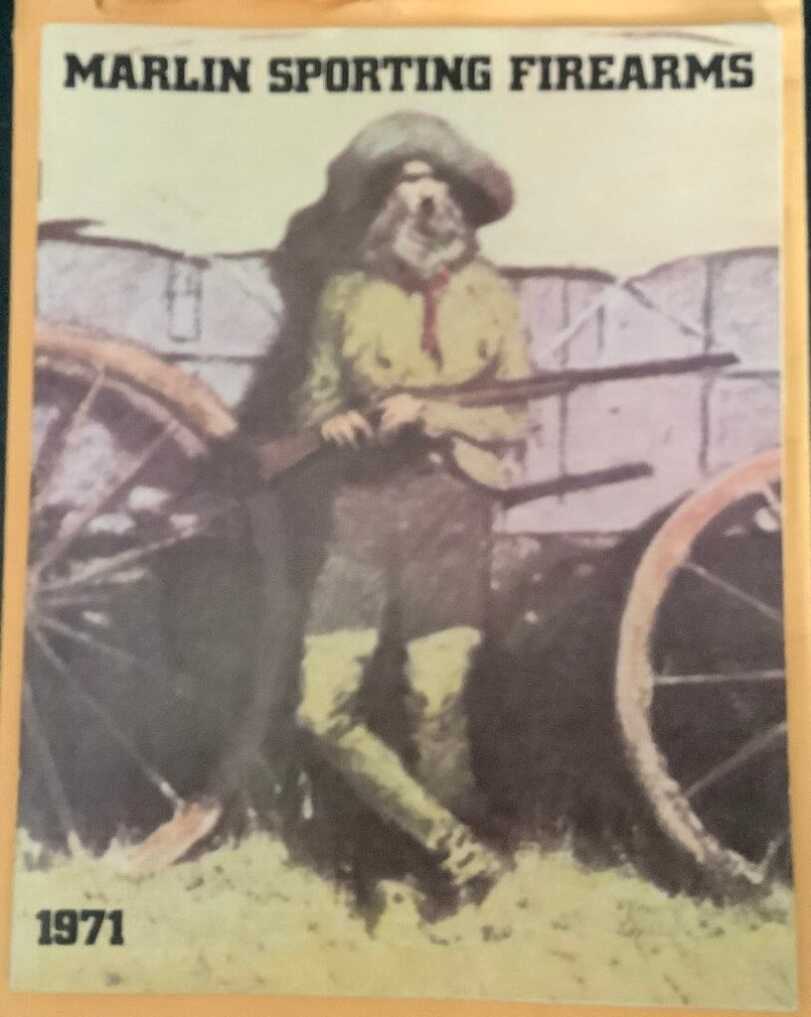
Table of contents
- Rumors Of The Time
- READ MORE: Marlin 1895 Dark – Reviewed
- Marlin 444 – A Never-Was Product
- The Marlin 444 Concept
- An Old Rumor Disproved
- READ MORE: Marlin Model 336: Long Live the Lever Gun! — SHOT Show 2023
- Finalizing The Concept
- Fabricating The Unobtainable
- Modification For A Modification
- Last Minute Notes
- One of one
The Monte Carlo stock and longer barrel, the dual bands on the forearm and mag tube. The image of the moose is perhaps what first placed my desire for one in my mind. Even if it only had 5 rounds, no hunter gets 5 shots at any animal. One accurate bullet was all it takes. Besides, Dad only gave me 5 rounds to put in guns at one time anyway. Such were the imaginings of an 8-year-old, still 4 years from returning to the USA.
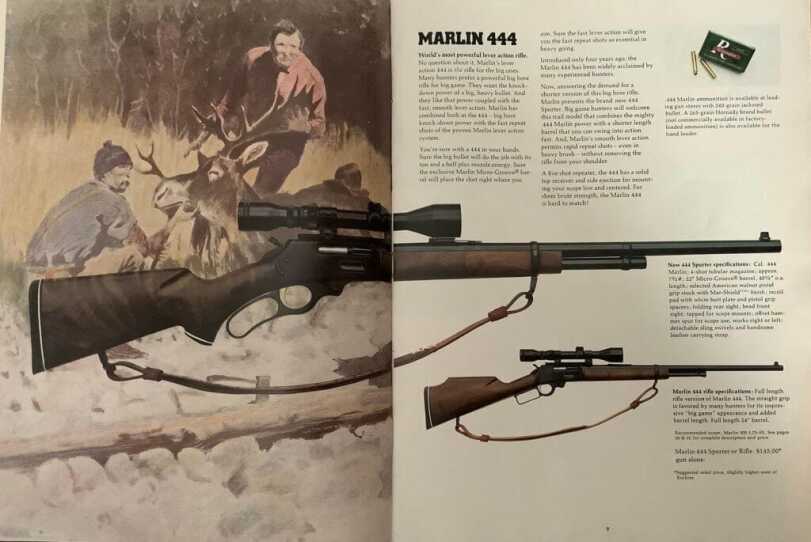
Rumors Of The Time
The writers had declared that the extra velocity provided by the 444 was too much for the 240gr. handgun bullets of the day. That the bullets were not providing the deep penetration required for the large game the 444 was designed for. Remington asserted the bullets used were NOT the same used in their 44 magnum loads. A few writers that had used the original loading were claiming good performance. The claims were overshadowed by the bad press and remarks of poor performance. The comments mentioned briefly that the poor-performing ammunition were using 44 handgun bullets. Using handgun designed bullets was not providing the desired performance.
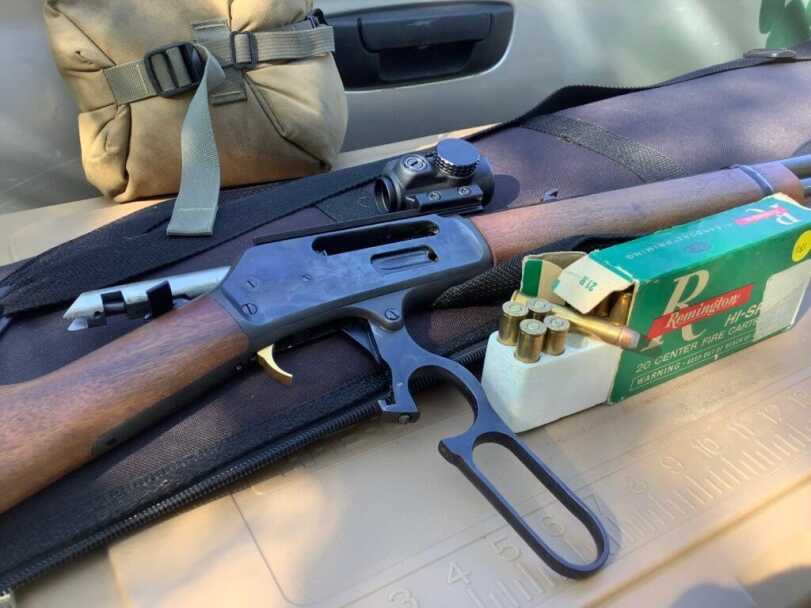
Today, we have bullet designs and bullet materials that we didn’t have back then. We also have more knowledge and experience, or at least we should have. Now we know that “ normal” handgun bullets made for 44 magnums were not performing as expected when pushed at Marlin 444 velocities. There are new materials now that manufacturers use for stouter, better-constructed projectiles.
READ MORE: Marlin 1895 Dark – Reviewed

Marlin 444 – A Never-Was Product
Despite my original desire for the Marlin 444 rifle with its 24” barrel, I grew to appreciate the usefulness of shorter barreled carbines or trappers. Also the large bores seemed to suffer less velocity loss with shortened barrels. This allows more handiness in the shorter rifles and still retains good velocity for bullet performance. I still liked the look of the Monte Carlo stock and double barrel bands. I decided that it would be that version that I would use for my project. So while I set about searching for a reasonably priced vintage Marlin in that configuration. I gave further thought to how I would convert it into a gun that never was.

My thoughts were that by using the dual barrel bands, I could easily shorten the barrel, and lengthen the magazine tube. Then utilize them to effectively secure the magazine tube to the barrel. The gun would look and function much like a standard 336T, with a full-length magazine tube and a 16.5” barrel. Upon locating a suitable Marlin, my first action was to take a hacksaw to the barrel. I cut the barrel, replaced the front sight, and had the muzzle recrowned. I split the bottom of the band and slid the sight onto an old take-off barrel. This allowed me to enlarge it for a snug friction fit to the now shortened Marlin 444 barrel.
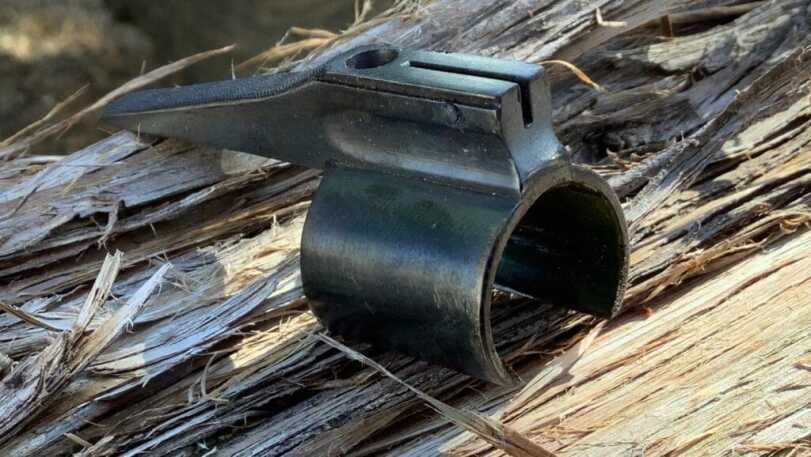
The Marlin 444 Concept
I cut the barrel intentionally longer than I actually desired. I cut it at 17 inches so I would have room for error and keep our government agencies happy. The rough concept model went on a hunt, and I used a box of vintage Remington 240gr. softpoints. A Burris RT-1 was mounted on the rifle and zeroed at 1.5 inches high at 50 yards. This provided a suitable trajectory for hunting out to 175 yards. Accuracy was more than acceptable, and I guesstimated velocity at 2200fps.

I had been able to get the rifle zeroed with 4 rounds, and then later ran 2 over my chronograph. Quite a surprise was warranted when the recorded velocities proved higher than expected. The two rounds showed 2383 and 2394fps. This level of performance from the shortened barrel was exactly what I was hoping for. I wanted to use the bullet on a big feral hog or a cow Nilgai. Both of which should be suitably tough and a good test for the old 240gr. bullets. Take the rumors and speculation of the past about the unsuitability of the Remington bullets with a grain of salt. I wanted to see firsthand how well or how poorly they would perform.
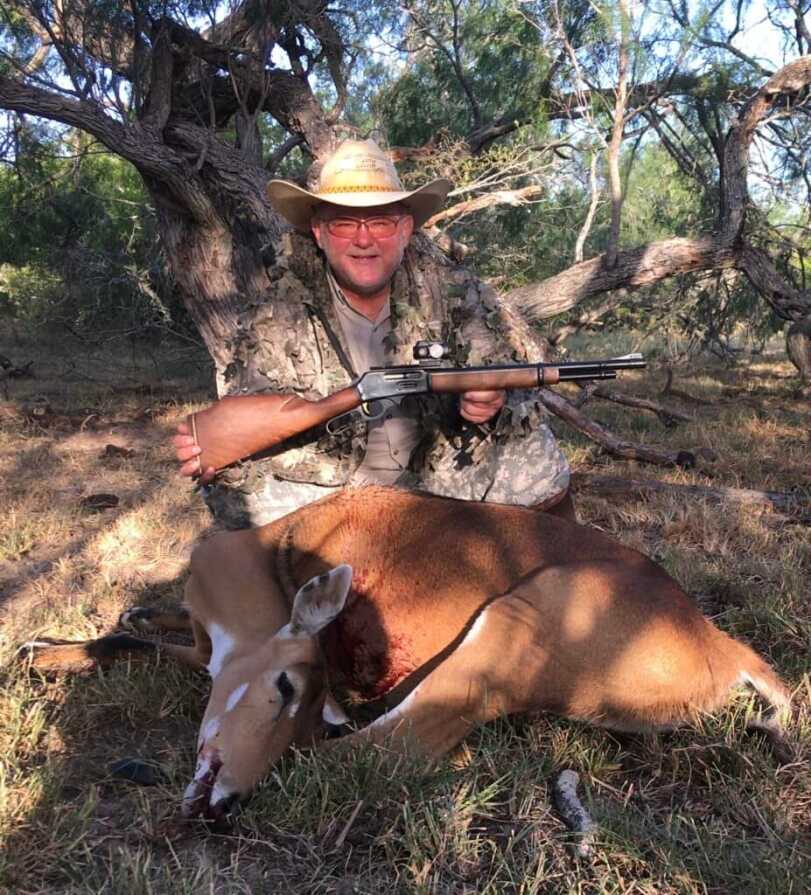
An Old Rumor Disproved
A day later I had a Nilgai cow inside 100 yards and placed two 240gr. softpoints in her chest cavity. The first shot was broadside at about 50 yards. The second a raking shot as she bolted for cover at 60 yards or so. She went another 10-15 yards and piled up. Given the high impact velocity, the bullets performed terrific as far as I’m concerned. I recovered both just under the hide on the offside, in classic mushroom shapes. Having traveled 20-26 inches, broken ribs upon entry, and created 1.5” and 1.75” entry holes.

READ MORE: Marlin Model 336: Long Live the Lever Gun! — SHOT Show 2023
I would expect deeper penetration with less impact velocity. Considering these bullets were old-school vintage cup and core ammunition they performed quite admirably. My intent was to use 270-280 grain bullets for my new rifle. However, I am likely to try some new all-copper or all-brass projectiles of 240-250 grain weight. I’ve got some bonded 250gr. bullets coming from Fury custom bullets.

Finalizing The Concept
Now that I had successfully proven my concept for the short Trapper gun. I completely disassembled the rifle. The stocks got sanded and refinished with Birchwood Casey TruOil, 7-8 coats. I fit a new NECG barrel band front sight. The sight was ordered after measuring the barrel diameter at 16”. My NECG sight was fitted due to barrel taper and it being parallel bored at .788. The barrel measured 790 at 16” and tapers to .795. The sight was fit, the muzzle was recrowned and the finished barrel length was set at 16.5”. I also lengthened the magazine tube to give the rifle its new look.
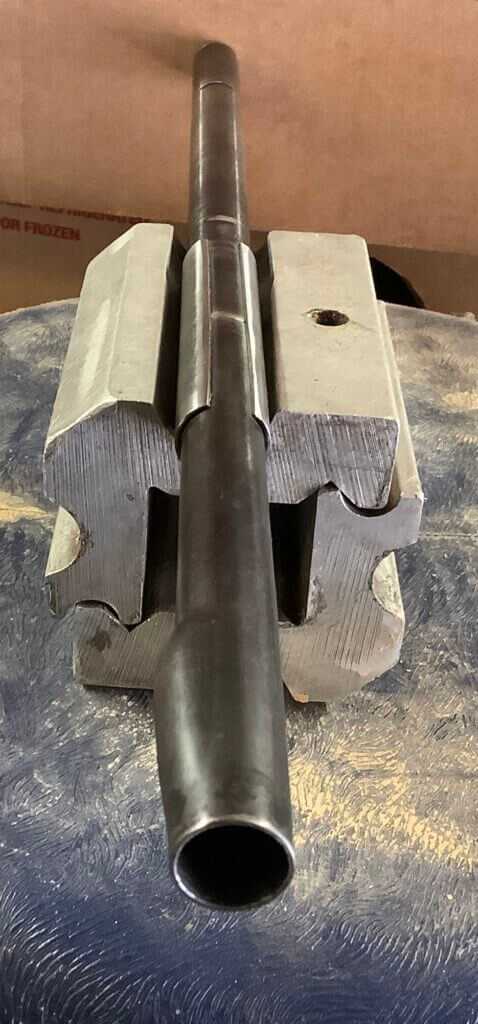
The magazine tube lengthening took some thought as searching for a replacement proved unsuccessful online. Luckily the external and internal diameters of the plentiful 30-30 type are the same as those of the Marlin 444. The only visible differences are length and the bulge on the receiver end for the fatter round to feed. I considered cutting the muzzle end of one and having it welded to the receiver end of my 444 version. However, cleaning up the inside to allow rounds to feed could prove near impossible. I came upon the idea of simply joining the two ends and keeping them aligned with a pressure slip joint and Loctite.
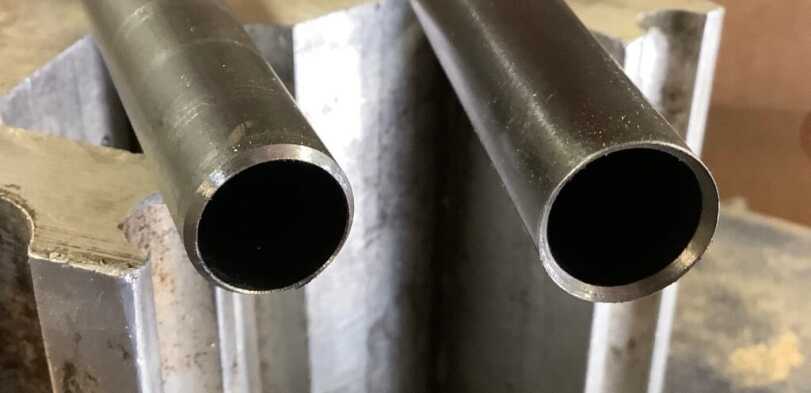
Fabricating The Unobtainable
This is how I managed it, I took a short 4.5” section of old magazine tube and slit it lengthwise. Cleaned up the edges with a file and sandpaper and degreasing it with acetone. I set it aside and went to work on preparing the two mag tube sections. I would chamfer the ends of each so that they would slip into each other as male and female ends. A case mouth chamfer tool was used for the inner chamfer. Then I set up my bench sander for the outer chamfer, setting the angle correctly. I used a straight edge for the mag tube section to be guided by. The two ends mated up very well and when held by the 4.5” section were extremely rigid.
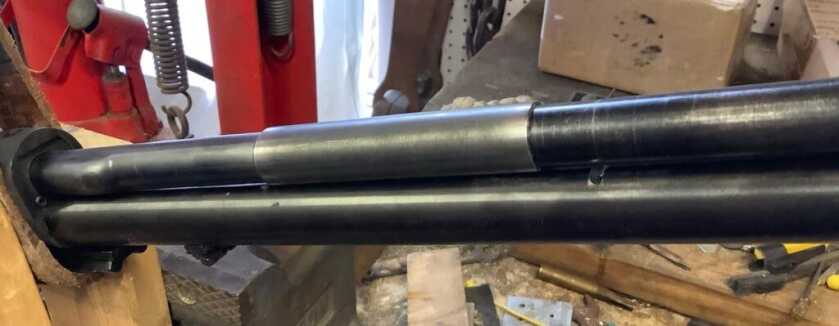
When fitting the pieces together ensure that the open section of the joint is located at the 12 o’clock position. As well as all notches and bulges of the mag tube located in their correct positions. The barrel and mag tube are so close they will not allow even that small increase in thickness. When I properly placed and assembled all the pieces. I dropped the magazine follower down the mag tube proving internally everything was seamless. I added a wicking grade medium Loctite to all the seams and ends of the joint to finalize assembly.
Modification For A Modification
Using the short 4.5” section meant I would need to enlarge slightly the forearm slot where the mag tube rides. I carefully filed and sanded the inside of the forearm, the exterior already finished with TruOil. Once the mag tube would ride inside the forearm without any pressure or contact. I sealed the inside with Birchwood Casey stock sealer and grain filler using a small disposable paintbrush.
The modified barrel and mag tube would need refinishing. I decided to not refinish the entire barreled action assembly and only do the barrel and mag tube. So I taped off the front of the receiver and everything beyond it. I applied Brownells Aluma-Hyde II on those parts that were sanded, filed, or bare metal. The barrel bands were unmodified and left in original finish.

Last Minute Notes
Brownells claims 10 -14 days for full cure of the Aluma-Hyde II. I worked on the wood with Birchwood Casey stock sheen. Removing small imperfections in the finish and giving the wood a nice smooth less shiny luster. Assembly would include following the directions found in Accurizing the Factory rifle, written by M.L.McPherson.

When assembling lever actions a small bit of play helps between mag tube, receiver, and barrel. This allows no pressure to inhibit accuracy. A bit of battering can take place on the small pins and screws holding the forearm and mag tube. Since this is a large bore gun and recoils more substantially than a 30-30 or 44 magnum. I will reassemble according to Mr. McPherson’s instructions. This utilizes RTV at key locations to eliminate looseness but not deal with hard pressure points.
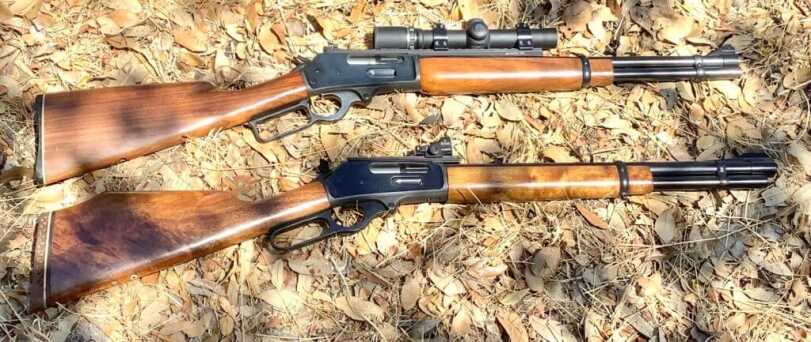
One of one
Assembled and complete, I now have a rifle that never was but should have been. Perhaps now that Ruger has seen to offering a Marlin 45-70 Trapper. A Trapper Marlin 444 version will be in our future. A stainless steel version would be excellent. Although I much prefer my one-off without the threaded muzzle and cross bolt safety.
*** Buy and Sell on GunsAmerica! ***


excellent article
being left eye dominant ive always had a love of lever actions and it looks like you put together a good one. kudos
The old Hornady 265gr hollow point available years ago (still may be?) worked great in the 444. But to me the 45-70 is a much more versatile round, cheaper, and much more readily available.
For those who like the .444 but don’t gunsmith, know that you can find Winchester 94AE’s in .444 with a 18″ barrel. While I have loved Marlins since my Dad bought me my first 60 years ago, the 94 is a fast little rifle too.
With all the push for the newest wizz bang cartridge, nice to see that somebody sees the value of “obsolete” cartridges like the 444 Marlin. In a number of cases, using modern powders and bullets, these “obsolete” rounds are more effective than when they first were introduced. Like the modern 45/70 loads, the 444 Marlin is more capable than before, and a “Trapper” model, modified so it could also feed 44 Mag rounds (think 38 spl/357 mag rifles) and function properly, would be the ideal “Brush”, “Camp”, or even “Hogg” rifle. As for RUGER now building Marlin rifles, think it was a smart move by RUGER. Knew Marlin was in trouble when at a NRA convention years ago asked a Marlin rep if they would build a 1894 rifle in 327 mag, and told that as it is a rimless cartridge, it would never work in a lever action rifle. Seems that he forgot that the Marlin model 62 was built to run 30 Carbine rounds, and as it used a special (not a M1 Carbine) magazine that was never available.
MY FAVORITE FOR THE NORTHEASTERN STATES WAS A WINCH. MODEL 100 SEMI AUTO WITH 130 – 145 GRAIN BULLETS FOR WHITE TAIL AND BROWN BEARS – I BELIEVE THE .308 GOES UP TO A 220 GRAIN BULLET FOR BIGGER ANIMALS .
Please tell me where in the N.E. you hunted brown bears. Having grown up in “Remington Country” I was never fortunate as you to encounter one.
Like you…..my youthful dreams were filled with an “abbreviated length” Marlin Lever Gun.
Finally found one of the scarce “Marauder” models.
Dreams DO come true.
Appreciate your detailed walk through creating the .444 Marlin Trapper that NEVER WAS.
Thanks,
Chuck